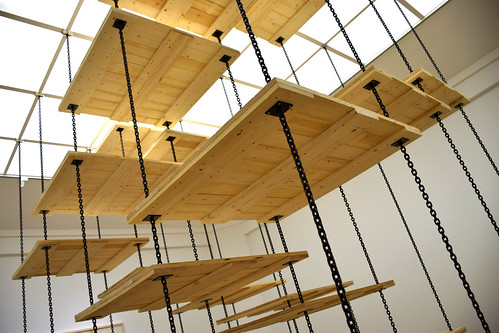For the New York Times, Nina Siegal writes about Constant Nieuwenhuys, nom de guerre Constant, who is the subject of two Dutch retrospectives. The artist, who went on to work in various media including furniture and architectural design, was a member of CoBrA, and remains relatively underknown in the US. Read Siegel in partial below, in full via the New York Times.
AMSTERDAM — At the end of World War II, a group of young artists based in Copenhagen, Brussels and Amsterdam responded to the devastation around them by creating works characterized by a burst of color and childlike expressivity.
They called their movement CoBrA, combining the first parts of the names of their home cities. And one of the leading Dutch practitioners was Constant Nieuwenhuys, who often went simply by the name Constant.
CoBrA’s brief, intense life ended in 1951, when the various artists veered off in different directions.
Constant moved to Paris and switched gears entirely, moving away from painting and focusing instead on developing a new utopian vision of the world, which he called New Babylon. He spent the next two decades absorbed in this vision, which he expressed through a variety of media, including architecture, sculpture, furniture design, photography, geographical maps and philosophical writings.
The works of this fertile period are the subject of two concurrent exhibitions in the Netherlands, both ending Sept. 25.
“Constant. Space + Color: From CoBrA to New Babylon,” at the Cobra Museum for Modern Art in Amstelveen, just south of Amsterdam, explores the transition between these two poles of Constant’s work with 144 artworks.
At the Gemeentemuseum in The Hague, “Constant — New Babylon. To Us Liberty” features a larger retrospective of about 160 works from the New Babylon period, 1956 to 1974, and the steps he took in the late 1940s and early 1950s that led up to that work.
Constant’s vision rested on the birth of a new kind of human. Freed from work by anticipated automation of all kinds of production, people would become more playful, experimental and less bound to traditional home and work spaces — becoming a creative creature he called Homo Ludens, or man at play. These future creative types would need more flexible working and living spaces, and they’d develop new kinds of social networks to enable them to share resources.
Much of his work depicts a kind of endless, interlocked labyrinth of homes and creative spaces, often employing then-new materials like colored plexiglass.
“I think you can say it was an obsession,” said Laura Stamps, curator of the Gemeentemuseum exhibition. “I think you have to be very focused to make such a big piece of art and work on it on so many levels and find so many ways to express your ideas.”
Ludo van Halem, co-curator of the Cobra Museum exhibition, added: “It’s really a grand vision for humankind. He’s thinking about how people will look in 100 or 200 years, how people will behave. It’s also not only an artistic vision but also, on a philosophical level, a sketch for a culture, and it’s really a very daring thing to do. It’s also still about aesthetics. They’re still works of art, even his earliest models.”
The two exhibitions and a third, at the Museum Reina Sofia in Madrid from late 2015 to earlier this year, were brought about in part through the efforts of Constant’s widow and biographer, Trudy Nieuwenhuys-van der Horst, who is on the board of the Utrecht-based Fondation Constant.
The Madrid show had a particularly strong response from younger visitors, who felt that Constant’s work was relevant to their perceptions of today’s society, Ms. Nieuwenhuys-van der Horst said.
“The vision of Constant that people should change in more nomadic and less possessive lifestyles, in the sense they don’t need their own houses, cars, books etc., is happening now,” she wrote in an email. “See how many young people are sharing their homes, cars, books, furniture, household utensils and prefer to travel around the world instead of only and predominantly investing in houses and cars.”
View of Constant’s “Playful Stairs” (1968) via Flickr
